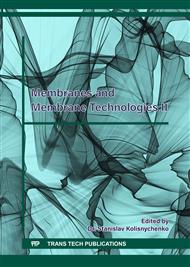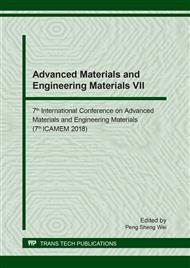[1]
S.S.M. Lock, K.K. Lau, F. Ahmad, A.M. Shariff, Modeling, simulation and economic analysis of CO2 capture from natural gas using cocurrent, countercurrent and radial crossflow hollow fiber membrane, Int. J. Greenh. Gas Control 36 (2015) 114-134.
DOI: 10.1016/j.ijggc.2015.02.014
Google Scholar
[2]
T. Burdyny, H. Struchtrup, Hybrid membrane/cryogenic separation of oxygen from air for use in the oxy-fuel process, Energ. 35(5) (2010) 1884-1897.
DOI: 10.1016/j.energy.2009.12.033
Google Scholar
[3]
H. Lin, M. Zhou, J. Ly, J. Vu, J.G. Wijmans, T.C. Merkel, J. Jin, A. Haldeman, E.H. Wagener, D. Rue, Membrane-Based Oxygen-Enriched Combustion, Ind. Eng. Chem. Res. 52(31) (2013) 10820-10834.
DOI: 10.1021/ie401464z
Google Scholar
[4]
B. Belaissaoui, Y. Le Moullec, H. Hagi, E. Favre, Energy efficiency of oxygen enriched air production technologies: Cryogeny vs membranes, Sep. Purif. Techol. 125 (2014) 142-150.
DOI: 10.1016/j.seppur.2014.01.043
Google Scholar
[5]
M.A. Habib, M.A. Nemitallah, D. Afaneh, K. Mezghani, Characteristic of air separation in hollow-fiber polymeric membrane for oxygen enriched air clean combustion applications, J. Clean. Prod. 143 (2017) 960-972.
DOI: 10.1016/j.jclepro.2016.12.025
Google Scholar
[6]
S.S.M. Lock, K.K. Lau, A.M. Shariff, Y.F. Yeong, Preliminary techno-economic and environmental assessment of thickness dependent physical aging in oxygen enriched combustion using polymeric membranes, J. Clean. Prod. 162 (2017) 914-937.
DOI: 10.1016/j.jclepro.2017.06.089
Google Scholar
[7]
S.S.M. Lock, K.K. Lau, M. Irene Lock Sow, A.M. Shariff, Y.F. Yeong, A.M. Bustam, Molecular simulation and mathematical modelling of glass transition temperature depression induced by CO 2 plasticization in Polysulfone membranes, IOP Conference Series: Materials Science and Engineering 226(1) (2017).
DOI: 10.1088/1757-899x/226/1/012172
Google Scholar
[8]
M. Safari, A. Ghanizadeh, M.M. Montazer-Rahmati, Optimization of membrane-based CO2-removal from natural gas using simple models considering both pressure and temperature effects, Int. J. Greenh. Gas Con. 3(1) (2009) 3-10.
DOI: 10.1016/j.ijggc.2008.05.001
Google Scholar
[9]
F. Ahmad, K.K. Lau, A.M. Shariff, Y.F. Yeong, Temperature and pressure dependence of membrane permeance and its effect on process economics of hollow fiber gas separation system, J. Membr. Sci. 430 (2013) 44-55.
DOI: 10.1016/j.memsci.2012.11.070
Google Scholar
[10]
S.N. Wijenayake, N.P. Panapitiya, S.H. Versteeg, C.N. Nguyen, S. Goel, K.J. Balkus, I.H. Musselman, J.P. Ferraris, Surface Cross-Linking of ZIF-8/Polyimide Mixed Matrix Membranes (MMMs) for Gas Separation, Ind. Eng. Chem. Res. 52(21) (2013).
DOI: 10.1021/ie400149e
Google Scholar
[11]
N. Jusoh, Y.F. Yeong, K.K. Lau, A. M. Shariff, Enhanced gas separation performance using mixed matrix membranes containing zeolite T and 6FDA-durene polyimide, J. Membr. Sci. 525 (2017) 175-186.
DOI: 10.1016/j.memsci.2016.10.044
Google Scholar
[12]
N. Jusoh, Y.F. Yeong, K.K. Lau, S. A. M., Enhanced gas separation performance using mixed matrix membranes containing zeolite T and 6FDA-durene polyimide, J. Membr. Sci. 525 (2017) 175-186.
DOI: 10.1016/j.memsci.2016.10.044
Google Scholar
[13]
X. Duthie, S. Kentish, C. Powell, K. Nagai, G. Qiao, G. Stevens, Operating temperature effects on the plasticization of polyimide gas separation membranes, J. Membr. Sci. 294(1–2) (2007) 40-49.
DOI: 10.1016/j.memsci.2007.02.004
Google Scholar
[14]
S.S.M. Lock, K.K. Lau, A.M. Shariff, Y.F. Yeong, M.A. Bustam, Thickness dependent penetrant gas transport properties and separation performance within ultrathin polysulfone membrane: Insights from atomistic molecular simulation, J. Polym. Sci. Pt. B Polym. Phys. 56(2) (2018).
DOI: 10.1002/polb.24523
Google Scholar
[15]
Y. Huang, D.R. Paul, Effect of Temperature on Physical Aging of Thin Glassy Polymer Films, Macromol. 38 (2005) 10148-10154.
DOI: 10.1021/ma051284g
Google Scholar
[16]
Y. Huang, Physical Aging of Thin Glassy Polymer Films, Austin, (2005).
Google Scholar



